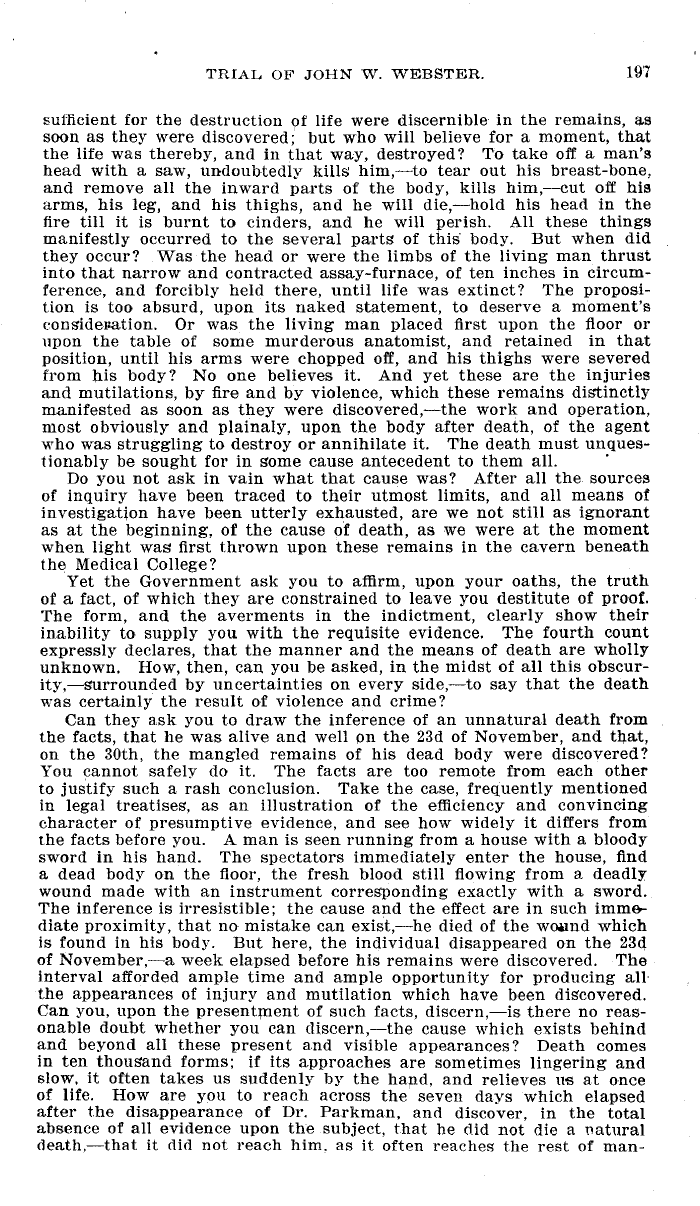|
TRIAL OF JOHN W. WEBSTER. 19'7
sufficient for the destruction of life were discernible in the remains, as
soon as they were discovered; but who will believe for a moment, that
the life was thereby, and in that way, destroyed? To take off a man's
head with a saw, undoubtedly kills him,-to tear out his breast-bone,
and remove all the inward parts of the body, kills him,--cut off his
arms, his leg, and his thighs, and he will die,-hold his head in the
fire till it is burnt to cinders, and he will perish. All these things
manifestly occurred to the several parts of this body. But when did
they occur? Was the head or were the limbs of the living man thrust
into that narrow and contracted assay-furnace, of ten inches in circum-
ference, and forcibly held there, until life was extinct? The proposi-
tion is too absurd, upon its naked statement, to deserve a moment's
consideration. Or was the living man placed first upon the floor or
upon the table of some murderous anatomist, and retained in that
position, until his arms were chopped off, and his thighs were severed
from his body? No one believes it. And yet these are the injuries
and mutilations, by fire and by violence, which these remains distinctly
manifested as soon as they were discovered,-the work and operation,
most obviously and plainaly, upon the body after death, of the agent
who was struggling to destroy or annihilate it. The death must unques-
tionably be sought for in some cause antecedent to them all. '
Do you not ask in vain what that cause was? After all the sources
of inquiry have been traced to their utmost limits, and all means of
investigation have been utterly exhausted, are we not still as ignorant
as at the beginning, of the cause of death, as we were at the moment
when light was first thrown upon these remains in the cavern beneath
the Medical College?
Yet the Government ask you to affirm, upon your oaths, the truth
of a fact, of which they are constrained to leave you destitute of proof.
The form, and the averments in the indictment, clearly show their
inability to supply you with the requisite evidence. The fourth count
expressly declares, that the manner and the means of death are wholly
unknown. How, then, can you be asked, in the midst of all this obscur-
ity,-surrounded by uncertainties on every side,-to say that the death
was certainly the result of violence and crime?
Can they ask you to draw the inference of an unnatural death from
the facts, that he was alive and well on the 23d of November, and that,
on the 30th, the mangled remains of his dead body were discovered?
You cannot safely do it. The facts are too remote from each other
to justify such a rash conclusion. Take the case, frequently mentioned
in legal treatises, as an illustration of the efficiency and convincing
character of presumptive evidence, and see how widely it differs from
the facts before you. A man is seen running from a house with a bloody
sword in his hand. The spectators immediately enter the house, find
a dead body on the floor, the fresh blood still flowing from a, deadly
wound made with an instrument corresponding exactly with a sword.
The inference is irresistible; the cause and the effect are in such imme^
diate proximity, that no mistake can exist,-he died of the wound which
is found in his body. But here, the individual disappeared on the 23d
of November,-a week elapsed before his remains were discovered. The
interval afforded ample time and ample opportunity for producing all
the appearances of injury and mutilation which have been discovered.
Can you, upon the presentment of such facts, discern,-is there no reas-
onable doubt whether you can discern,-the cause which exists behind
and beyond all these present and visible appearances? Death comes
in ten thousand forms; if its approaches are sometimes lingering and
slow, it often takes us suddenly by the hand, and relieves us at once
of life. How are you to reach across the seven days which elapsed
after the disappearance of Dr. Parkman, and discover, in the total
absence of all evidence upon the subject. that he did not die a natural
death,-that it did not reach him. as it often reaches the rest of man-
|

